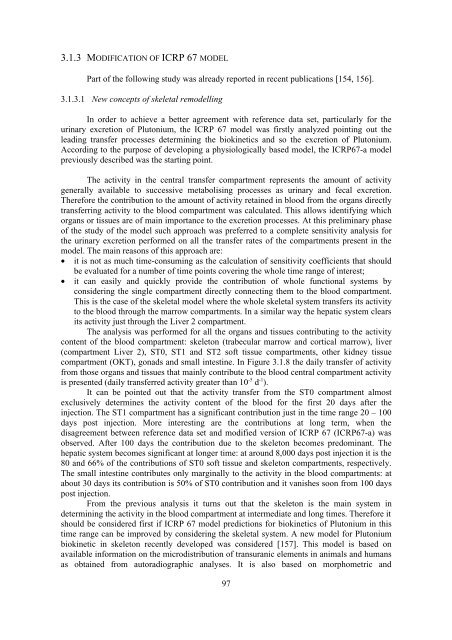Plutonium Biokinetics in Human Body A. Luciani - Kit-Bibliothek - FZK
Plutonium Biokinetics in Human Body A. Luciani - Kit-Bibliothek - FZK
Plutonium Biokinetics in Human Body A. Luciani - Kit-Bibliothek - FZK
Create successful ePaper yourself
Turn your PDF publications into a flip-book with our unique Google optimized e-Paper software.
3.1.3 MODIFICATION OF ICRP 67 MODEL<br />
Part of the follow<strong>in</strong>g study was already reported <strong>in</strong> recent publications [154, 156].<br />
3.1.3.1 New concepts of skeletal remodell<strong>in</strong>g<br />
In order to achieve a better agreement with reference data set, particularly for the<br />
ur<strong>in</strong>ary excretion of <strong>Plutonium</strong>, the ICRP 67 model was firstly analyzed po<strong>in</strong>t<strong>in</strong>g out the<br />
lead<strong>in</strong>g transfer processes determ<strong>in</strong><strong>in</strong>g the biok<strong>in</strong>etics and so the excretion of <strong>Plutonium</strong>.<br />
Accord<strong>in</strong>g to the purpose of develop<strong>in</strong>g a physiologically based model, the ICRP67-a model<br />
previously described was the start<strong>in</strong>g po<strong>in</strong>t.<br />
The activity <strong>in</strong> the central transfer compartment represents the amount of activity<br />
generally available to successive metabolis<strong>in</strong>g processes as ur<strong>in</strong>ary and fecal excretion.<br />
Therefore the contribution to the amount of activity reta<strong>in</strong>ed <strong>in</strong> blood from the organs directly<br />
transferr<strong>in</strong>g activity to the blood compartment was calculated. This allows identify<strong>in</strong>g which<br />
organs or tissues are of ma<strong>in</strong> importance to the excretion processes. At this prelim<strong>in</strong>ary phase<br />
of the study of the model such approach was preferred to a complete sensitivity analysis for<br />
the ur<strong>in</strong>ary excretion performed on all the transfer rates of the compartments present <strong>in</strong> the<br />
model. The ma<strong>in</strong> reasons of this approach are:<br />
• it is not as much time-consum<strong>in</strong>g as the calculation of sensitivity coefficients that should<br />
be evaluated for a number of time po<strong>in</strong>ts cover<strong>in</strong>g the whole time range of <strong>in</strong>terest;<br />
• it can easily and quickly provide the contribution of whole functional systems by<br />
consider<strong>in</strong>g the s<strong>in</strong>gle compartment directly connect<strong>in</strong>g them to the blood compartment.<br />
This is the case of the skeletal model where the whole skeletal system transfers its activity<br />
to the blood through the marrow compartments. In a similar way the hepatic system clears<br />
its activity just through the Liver 2 compartment.<br />
The analysis was performed for all the organs and tissues contribut<strong>in</strong>g to the activity<br />
content of the blood compartment: skeleton (trabecular marrow and cortical marrow), liver<br />
(compartment Liver 2), ST0, ST1 and ST2 soft tissue compartments, other kidney tissue<br />
compartment (OKT), gonads and small <strong>in</strong>test<strong>in</strong>e. In Figure 3.1.8 the daily transfer of activity<br />
from those organs and tissues that ma<strong>in</strong>ly contribute to the blood central compartment activity<br />
is presented (daily transferred activity greater than 10 -5 d -1 ).<br />
It can be po<strong>in</strong>ted out that the activity transfer from the ST0 compartment almost<br />
exclusively determ<strong>in</strong>es the activity content of the blood for the first 20 days after the<br />
<strong>in</strong>jection. The ST1 compartment has a significant contribution just <strong>in</strong> the time range 20 – 100<br />
days post <strong>in</strong>jection. More <strong>in</strong>terest<strong>in</strong>g are the contributions at long term, when the<br />
disagreement between reference data set and modified version of ICRP 67 (ICRP67-a) was<br />
observed. After 100 days the contribution due to the skeleton becomes predom<strong>in</strong>ant. The<br />
hepatic system becomes significant at longer time: at around 8,000 days post <strong>in</strong>jection it is the<br />
80 and 66% of the contributions of ST0 soft tissue and skeleton compartments, respectively.<br />
The small <strong>in</strong>test<strong>in</strong>e contributes only marg<strong>in</strong>ally to the activity <strong>in</strong> the blood compartments: at<br />
about 30 days its contribution is 50% of ST0 contribution and it vanishes soon from 100 days<br />
post <strong>in</strong>jection.<br />
From the previous analysis it turns out that the skeleton is the ma<strong>in</strong> system <strong>in</strong><br />
determ<strong>in</strong><strong>in</strong>g the activity <strong>in</strong> the blood compartment at <strong>in</strong>termediate and long times. Therefore it<br />
should be considered first if ICRP 67 model predictions for biok<strong>in</strong>etics of <strong>Plutonium</strong> <strong>in</strong> this<br />
time range can be improved by consider<strong>in</strong>g the skeletal system. A new model for <strong>Plutonium</strong><br />
biok<strong>in</strong>etic <strong>in</strong> skeleton recently developed was considered [157]. This model is based on<br />
available <strong>in</strong>formation on the microdistribution of transuranic elements <strong>in</strong> animals and humans<br />
as obta<strong>in</strong>ed from autoradiographic analyses. It is also based on morphometric and<br />
97












![{A1[]Sp - Bibliothek](https://img.yumpu.com/21908054/1/184x260/a1sp-bibliothek.jpg?quality=85)




